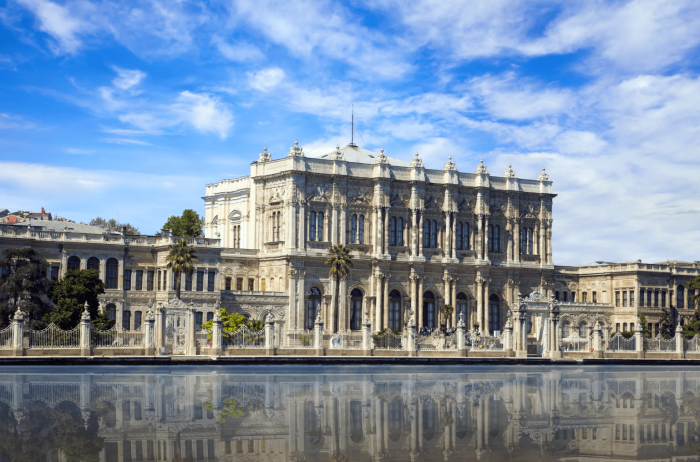
During the Ottoman Empire, marble was a widely used material, especially in monumental architectural structures. The marble used in these buildings was often sourced from marble quarries in the Ottoman lands or from Anatolia, providing not only aesthetic beauty but also structural integrity. The prevalence of marble, particularly in the construction of mosques and palaces, serves as a testament to the importance of this material in Ottoman architectural heritage.
The Use of Marble in Mosques
The use of marble began during the height of the Ottoman Empire. Initially, marble from the Marmara region was employed, but over time, other types of marble in various colors, as well as stones like granite, were incorporated. These precious materials were used in various parts of buildings, ranging from structural elements to decorative features. For example, in the Sultan Selim Mosque, white marble was prominently featured in the courtyard, the main gate, the mihrab, and the pulpit. Similarly, during the construction of the Süleymaniye Mosque, four major marble columns were sourced from different regions of the world, including Lebanon, Alexandria, and the Byzantine era Kıztaşı, with one column coming from Topkapı Palace. The white marble used in the mosque was sourced from Marmara Island, while green marble came from Arabia.
Marble in Topkapı Palace
Topkapı Palace, constructed by Fatih Sultan Mehmed after the conquest of Istanbul, showcases some of the finest examples of marble use in Ottoman architecture. Serving as the administrative, educational, and cultural center of the empire for 400 years, Topkapı Palace includes a variety of rooms and sections adorned with marble. The Kubbealtı section features marble-covered interior walls, while in the Babüssaade section, four marble columns with Ionic capitals support a wooden ceiling. In the III. Courtyard, also known as the Enderun Courtyard, the marble terrace and other architectural features contribute to the palace’s grandeur. Notably, the Arz Room contains a marble relief praising Sultan Abdulmecid. The Enderun Library’s exterior is covered in marble, and the fountain beneath the domes of the Has Oda is made of marble. One particularly significant detail is a white marble platform, or “seki,” located to the left when entering the Has Oda; this was where the bodies of deceased sultans were placed.

Topkapı Palace
Marble in Dolmabahçe Palace
Dolmabahçe Palace, a symbol of the Ottoman Empire’s shift towards Westernization, also features marble extensively in its design. Built with the contributions of both Ottoman and European architects, the palace’s construction utilized Marmara marble. Notably, the palace’s marble quay spans 600 meters, while the hammams within the palace are richly adorned with marble. The marble fountain in the baroque style, as well as other marble details, demonstrate the aesthetic and functional versatility of marble in Ottoman palaces.

Dolmabahce Palace
Reused Marble in Ottoman Architecture
In some cases, marble was not newly quarried but reused from earlier structures, which reflects the economic and resourceful practices of the period. For example, the columns of the Çoban Mustafa Paşa Mosque in Gebze were brought from Egypt, and those of the Yeni Mosque in Eminönü were sourced from Crete. Up until a certain period, instead of extracting new marble, material from ancient, Byzantine, and even Roman buildings was repurposed. This reuse of marble often meant that local quarries like those in Marmara Island and the Kapıdağ Peninsula were underutilized, with architects opting for materials from older structures.
Marble in Ottoman Cemeteries
Marble’s use in tombstones also evolved during the Ottoman era. Prior to the second quarter of the 18th century, marble tombstones were rare and predominantly used by the elite. However, by the mid-18th century, marble became more accessible and increasingly used across different social classes. This democratization of marble, particularly in the 19th century, indicates that the material became more affordable as its availability increased, allowing it to be used by a broader population.

Sultan Ahmet Mosque

Sultan Selim Mosque

Yeni Mosque
Marble in Fountains
The use of marble extended to fountains as well, with a noticeable increase in marble fountains in the Galata district of Istanbul during the first half of the 18th century. This rise in the number of marble fountains and tombstones can be attributed to the revival of marble quarries on Marmara Island and the Kapıdağ Peninsula, which made marble more affordable and easier to transport to Istanbul.
So, the rich history of marble use in Ottoman architecture continues to influence modern design and construction. The skillful application of marble, whether for structural or decorative purposes, showcases the empire’s mastery of the material. As the centuries passed, the accessibility of marble allowed its use to spread across various architectural domains, from mosques and palaces to cemeteries and fountains, further cementing its place as a cornerstone of Ottoman design. For those looking to draw inspiration from this rich architectural tradition, the expertise developed through centuries of marble craftsmanship continues to provide valuable insights into how marble can be beautifully and effectively incorporated into modern projects.
